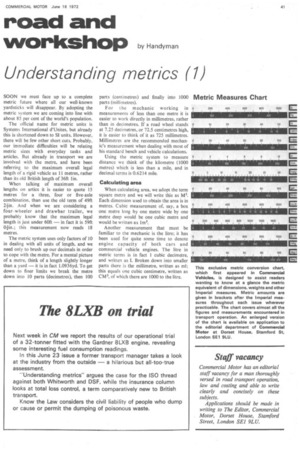road and
Page 43

If you've noticed an error in this article please click here to report it so we can fix it.
workshop by Handyman
Understanding metrics (1)
SOON we must face up to a complete metric future where all our well-known yardsticks will disappear. By adopting the metric system we are coming into line with about 85 per cent of the world's population.
The official name for metric units is Systems International d'Unites, but already this is shortened down to Si units. However, there will be few other short cuts. Probably, our immediate difficulties will be relating metric sizes with everyday tasks and articles. But already in transport we are involved with the metre, and have been referring to the maximum overall legal length of a rigid vehicle as 11 metres, rather than its old British length of 36ft lin.
When talking of maximum overall lengths on artics it is easier to quote 15 metres for a three, four or five-axle combination, than use the old term of 49ft 2fin. And when we are considering a four-wheeler and drawbar trailer, we probably know that the maximum legal length is just under 60ft — in fact it is 59ft Ofin.; this measurement now reads 18 metres.
The metric system uses only factors of 10 in dealing with all units of length, and we need only to brush up our decimals in order to cope with the metre. For a mental picture of a metre, think of a length slightly longer than a yard — it is in fact 1.0936yd. To get down to finer limits we break the metre down into 10 parts (decimetres), then 100
parts (centimetres) and finally into 1000 parts (millimetres).
For the mechanic working in measurements of less than one metre it is easier to work directly in millimetres, rather than in decimetres. If a road wheel stands at 7.25 decimetres, or 72.5 centimetres high, it is easier to think of it as 725 millimetres. Millimetres are the recommended mechanic's measurement when dealing with most of his standard bench and vehicle calculations.
Using the metric system to measure distance we think of the kilometre (1000 metres) which is less than a mile, and in decimal terms is 0.6214 mile.
Calculating area
When calculating area, we adopt the term square metre and we will write this as M2. Each dimension used to obtain the area is in metres. Cubic measurement of, say, a box one metre long by one metre wide by one metre deep would be one cubic metre and would he written as 1m3.
Another measurement that must be familiar to the mechanic is the litre; it has been used for quite some time to denote engine capacity of both cars and commercial vehicle engines. The litre in metric terms is in fact 1 cubic decimetre, and written as I. Broken down into smaller parts there is the millimetre, written as ml; this equals one cubic centimetre, written as CM 3, of which there are 1000 to the litre.




























































































